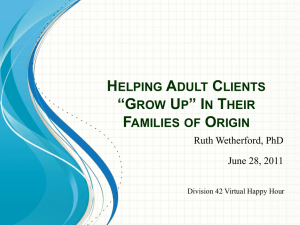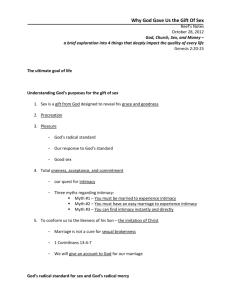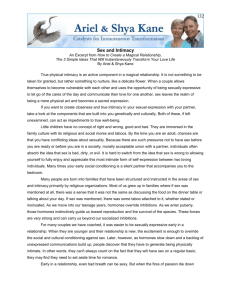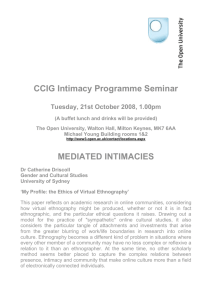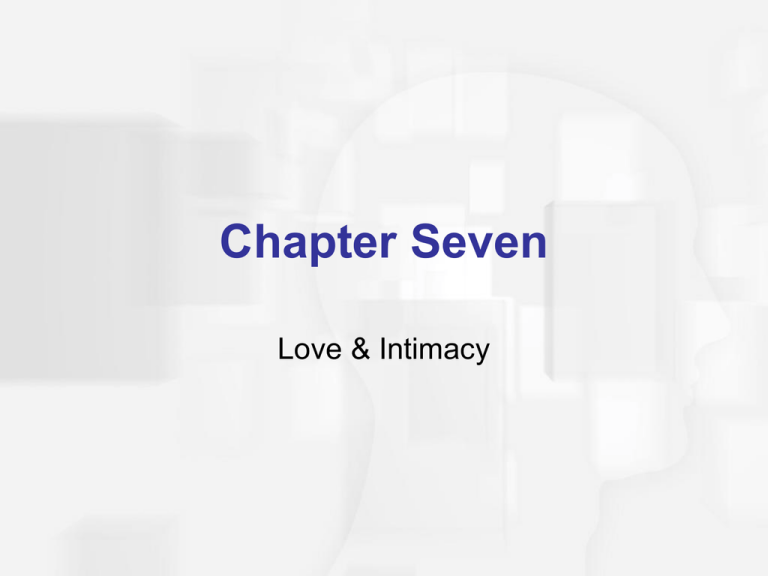
Chapter Seven
Love & Intimacy
Agenda
Review Theories of Love
Discuss Connection Between Love & Sex in
Intimate Relationships
Class Exercise:
Stereotypes and Intimacy
We will view a video clip from the movie
“What Women Want”
What are the stereotypes associated with
men/masculinity and women/femininity.
How do these stereotypes influence
intimacy?
Cultural Definitions of Love
The Forms and Origin of Love
Romantic love – passionate love that includes
sexual desire, physical attraction, and elation
We tend to idealize our romantic partner
Companionate love (conjugal love) – deep
affection, attachment, intimacy, trust, loyalty
Conceptualizations of Love
Colors of Love (Lee)
Love Triangles (Sternberg)
Can We Measure Love?
Colors of Love
(Lee, 1974, 1998)
Colors of Love
Based on research
Six basic ways (“colors”) to love
Love styles are independent
Lovers with compatible love styles will be
happier with each other than incompatible
styles
Six Contemporary Love Styles
(based on the work of Lee, 1973)
Eros (sounds like "air-ohs"): "characterized by
intense emotional attachment and powerful sexual
feelings or desires" (Lamanna & Riedmann, 1991, p.
92). Sustained relationships are typified by
"continued active interest in sexual and emotional
fulfillment, plus the development of intellectual
rapport" Lamanna & Riedmann, 1991, p. 92;
emphasis added).
Storge (sounds like "store-gay"): "an affectionate,
companionate style of loving. This love focuses on
deepening mutual commitment, respect, and
friendship over time" (Lamanna & Riedmann, 1991,
p. 92).
Continued …
Love Styles
Pragma: "emphasizes the practical element in
human relationships, particularly in marriages.
Pragmatics love involves rational assessment of a
potential partner's assets and liabilities" (Lamanna &
Riedmann, 1991, p. 92).
Agape: altruistic love. It "emphasizes unselfish
concern for the beloved's needs even when that
means some personal sacrifice. . . . [it also]
emphasizes nurturing others with little conscious
desire for return other than the intrinsic satisfaction of
having loved and cared for someone else" (Lamanna
& Riedmann, 1991, p. 92-93).
Continued …
Love Styles
Ludus (sounds like "lewd-us"): emphasizes
the recreational aspect of sexuality and
sensual pleasures. It may be part of a more
committed relationship based on other loves
styles, too.
Mania: based on strong sexual attraction and
emotional intensity, but a manic partner is
extremely jealous, moody, and her/his need
for attention is insatiable.
Colors of Love
Manic and ludic – poorer psychological health
Storge and eros – higher psychological health
Gender Differences:
Men – more socially acceptable to have
eros or ludus styles; less to have agape;
more likely to have ludic style
Women – more socially acceptable to have
agape; less to have ludus; more likely to
have pragmatic style
Love “Triangles”
(Sternberg, 1998, 1999)
Love Triangles
Love is three elements that can be combined
to produce 7 different types of love
Three basic elements:
Passion – sexual desire and physical
attraction; part of romantic love
Intimacy – connection and feelings of
closeness; an emotional investment
Commitment – to love in the short term; to
maintain that love in the long term
Love Triangles (Sternberg, 1998, 1999)
Love changes as we mature
Different forms of love may be experienced
within the same couple throughout time
Can We Measure Love?
Can We Measure Love?
Scales have been developed to measure love
Measure something strongly associated
with love
Attachment (Rubin, 1970, 1973)
Measure aspects of relationships
Relationship Rating Scale
Passionate Love Scale
Most scales measure romantic, not
companionate, love
Theories of Love
Behavioral Reinforcement Theories
Cognitive Theories
Physiological Arousal Theories
Evolutionary Theories
Class Exercise
Is love essential for emotional survival?
What are the characteristics of a truly loving
relationship?
How do you recognize love?
Is it possible to love more than one person in
a lifetime? More than one person at a time?
Behavioral Reinforcement Theories
We love because another person reinforces
positive feelings in ourselves
Positive/rewarding feeling in the presence of
another makes us like them, even if the
reward is unrelated to that person
Love is a result of many mutually reinforcing
activities with a person
Cognitive Theories
A behavior occurs, and then we interpret it as
love
If we think someone likes us, we are more
prone to find them attractive
Physiological Arousal Theories
Physiological arousal is labeled with an
emotion, such as love
We are more likely to experience love when
we are physiologically aroused for any reason
Shaky bridge study (Dutton & Aron, 1974)
Male participants on a “scary” bridge were
more likely than males on a “safe” bridge to
call a female they met on the bridge
Arousal is not crucial for an emotional state
Evolutionary Theories
Humans have 3 basic instincts:
Need for protection
Parent protects the child
Sexual drive
We love in order to produce offspring
Heterosexual men want healthy women to
carry offspring
Heterosexual women want men with
resources to care for her and the offspring
Love Across the Lifespan
Love becomes more complex as we
age
Childhood
Attachment to the caregiver can affect
attachment throughout life
The love of mother and father are important
May be harder to be intimate with another as
an adult if it was not experienced as a child
Three attachment types:
Secure – accepts caregiver leaving
Anxious/ambivalent – panic if left alone
Avoidant – caregiver forces parting early
Childhood
Parental divorce is related to lower levels of
trust a young adult (particularly female)
experiences in intimate relationships
Adolescence
Time to learn how to love, manage emotions
Creates a foundation for adult relationships
Role repertoire – varied ways to relate with
others
Intimacy repertoire – collection of behaviors
used to create intimate relationships in life
Usually begin with an unattainable crush;
romantic love more likely if parents’
relationship is stable, at ease with own body
Adult Love and Intimacy
Factors that increase attraction
Proximity – people you know or see often
Similarity – background, values, attitudes
Physical Attraction – “matching hypothesis”
Personality – openness, sociability, humor
Economic Resources – especially in men
Mutual Attraction and Love
Ideal qualities are consistent across gender,
culture, and sexual orientation
Attraction in Different Cultures
Study comparing 37 cultures (Buss, 1989)
Men valued “good looks” in their partner
Women valued “good financial prospect” in
their partner
Men preferred younger partners
Women preferred older partners
Love, Sex, and Intimacy
Intimate Relationships
Self-disclosure is important
Those who value intimacy tend to be more
trusting, concerned for others, disclose more,
have more positive thoughts about others,
are perceived as more likable, smile, laugh,
make more eye contact, and enjoy marriage
more
Male and Female Styles of Intimacy
Culturally transmitted gender roles may be
the largest factor in affecting style of intimacy
Men are inhibited from expressing intimacy,
or maybe they just do it differently than
women, such as through behavior
Gay men are more likely to believe in the
importance of sharing intimacy with a
romantic partner than heterosexual men
Intimacy in Different Cultures
Culture seems to be more influential than
gender in love and intimacy style
Individualistic vs. Collectivistic cultures
Strength of stereotypical gender roles affects
level of intimacy; the stronger the stereotype,
the less attached couples are
Western countries rate love as highly
important, less developed Asian countries
rated love the lowest
Long-Term Love and Commitment
Effort and commitment are required to
maintain a relationship
Women feel lonely in a marriage that has less
liking, marital satisfaction, self-disclosure, and
love
Men feel lonely in a marriage that has less
intimacy, liking, and communication
Love and Sex
Initial attraction increases intimacy: more eye
contact, more touches
Body language reveals attraction, and the
female typically starts
Initially it is contact and conversation with
bodies turned toward each other, followed by
tentative touches that increase in duration
and intimacy, then “full body synchronization”
Higher sexual desire, less unfaithful thoughts
Developing Intimacy Skills
Self-love – being at ease with ourselves, both
the positive and negative qualities
Receptivity – shows others we are open to
communication, approachable
Listening – provide full attention
Affection – warmth and security with others
Trust – a requirement that develops slowly
Respect – acknowledge and understand
another’s needs; don’t have to share them
The Dark Side of Love
Jealousy
Compulsiveness
Possessiveness
Class Exercise
A college couple who live together have been
having increased arguments.
One partner wants the other to grow up
and act mature.
In return, the other suggests that they need
to have more fun in their relationship.
What advice would you give them?
What are the short- and long-term prospects
for this couple?
Jealousy
Interpretation and emotional reaction that a
relationship is threatened
Most jealous if the person we believe is
threatening the relationship has qualities we
want ourselves
More common with low self-esteem
Jealousy
Men more jealous of a female’s sexual
infidelity
Women more jealous of a male’s emotional
infidelity
Both genders more threatened by sexual
infidelity in short-term relationships
Both genders more threatened by emotional
infidelity in long-term relationships
Jealousy
Male heterosexuals more jealous of malefemale sexual infidelity
Heterosexual women more jealous of malemale sexual infidelity
Much unknown about homosexual infidelity
Jealousy is in all cultures, although the
reasons may vary
Jealousy shows a lack of trust & self-esteem
Compulsiveness
Love releases phenylethylamine (also in
chocolate), which produces feelings of
euphoria and love addiction
Society and media reinforces the “need” to be
in love and may be carried over from
adolescence without maturing
Possessiveness
Trying to manipulate the partner in attempts
to feel worthy
Is a sign of low self-esteem and can lead to
stalking
May require help from a mental health
professional

